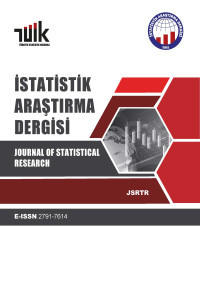Sağdan sansürlü veriler için veri madenciliği algoritmaları performanslarının karşılaştırılması
Sağdan sansürlü veri, Sınıflandırma, Veri madenciliği
Comparison of Data Mining Algorithms Performances for Right-Censored Data
Classification, Data Mining, Right-Censored Data,
___
- Ahmed, S. E., Aydin, D., & Yılmaz, E. (2020). Nonparametric regression estimates based on imputation techniques for right-censored data. Advances in Intelligent Systems and Computing, 1001, 109–120. https://doi.org/10.1007/978-3-030-21248-3_8
- Akpınar, H. (2014). Data : Veri Madenciliği Veri Analizi (Genişletil). Papatya Bilim Yayınevi.
- Alpar, R. (2013). Çok Değişkenli İstatistiksel Yöntemler. Detay Yayıncılık.
- Aydin, D., & Yilmaz, E. (2018). Modified spline regression based on randomly right-censored data: A comparative study. Communications in Statistics: Simulation and Computation, 47(9), 2587–2611. https://doi.org/10.1080/03610918.2017.1353615
- Balaban, M. E., & Kartal, E. (2015). Veri Madenciliği ve Makine Öğrenmesi Temel Algoritmaları ve R Dili İle Uygulamaları (Birinci Ba). Çağlayan Kitapevi.
- Bandyopadhyay, S., Wolfson, J., Vock, D. M., Vazquez-Benitez, G., Adomavicius, G., Elidrisi, M., Johnson, P. E., & O’Connor, P. J. (2015). Data mining for censored time-to-event data: a Bayesian network model for predicting cardiovascular risk from electronic health record data. In Data Mining and Knowledge Discovery (Vol. 29, Issue 4, pp. 1033–1069). https://doi.org/10.1007/s10618-014-0386-6
- Batista, G. E. A. P. A., & Monard, M. C. (2002). A study of k-nearest neighbour as an imputation method. In Frontiers in Artificial Intelligence and Applications (Vol. 87, pp. 251–260).
- Bishop, C. M. (2006). Pattern Recognition and Machine Learning. Springer.
- Bramer, M. (2007). Principles of Data Mining. Undergraduate Topics in Computer Science. Springer Verlag.
- Davidson, I., & Tayi, G. (2009). Data preparation using data quality matrices for classification mining. In European Journal of Operational Research (Vol. 197, Issue 2, pp. 764–772). https://doi.org/10.1016/j.ejor.2008.07.019
- Eröz, İ., & Tutkun, N. A. (2020). Aralıklı Sansürlü Veriler için Sağkalım Modelleri. Süleyman Demirel Üniversitesi Fen Bilimleri Enstitüsü Dergisi, 24(2), 267–280. https://doi.org/DOI: 10.19113/sdufenbed.652776
- Frank, E., Hall, B., & Pfahringer, B. (2003). Locally weighted naive bayes. Proceedings of Conference on Uncertainty in Artificial Intelligence, 249–256.
- Gamgam, H., & Altunkaynak, B. (2017). SPSS Uygulamalı Regresyon Analizi (2. Basım). Seçkin Kitapevi. Gijbels, I. (2010). Censored data. Wiley Interdisciplinary Reviews: Computational Statistics, 2(2), 178–188. https://doi.org/10.1002/wics.80
- Goldberg, Y., & Kosorok, M. R. (2012). Q-learning with censored data. Annals of Statistics, 40(1), 529–560. Guo, G., Wang, H., Bell, D., Bi, Y., & Greer, K. (2003). KNN Model-Based Approach in Classification. In R. Meersman, Z. Tari, & D. C. Schmidt (Eds.), On The Move to Meaningful Internet Systems 2003: CoopIS, DOA, and ODBASE (pp. 986–996). Springer Berlin Heidelberg.
- Han, J., Kamber, M., & Pei, J. (2012). Data Mining Concepts and Techniques (Third Edit). Morgan Kaufman Publishers. Harrington, P. (2012). Machine Learning In Action. Manning Publications.
- Hosmer, D. W., Lemeshov, S., & Sturdivant, R. X. (2013). Applied Logistic Regression (Third Edit). John Wiley & Sons, Inc.
- Ishwaran, H., Kogalur, U. B., Blackstone, E. H., & Lauer, M. S. (2008). Random survival forests. Ann. Appl. Stat., 2(3), 841–860.
- Khan, F. M., & Zubek, V. B. (2008). Support vector regression for censored data (SVRc): A novel tool for survival analysis. Proceedings - IEEE International Conference on Data Mining, ICDM, 863–868. https://doi.org/10.1109/ICDM.2008.50
- Lewis, N. D. (2017). Machine Learning Made Easy with R: An Intuitive Step by Step Blueprint for Beginners. CreateSpace Independent Publishing Platform.
- McNamara, J. M., Green, R. F., & Olsson, O. (2006). Bayes’ Theorem and Its Applications in Animal Behaviour. Oikos, 112(2), 243–251. http://www.jstor.org/stable/3548663
- Mucherino, A., Papajorgji, P. J., & Paradalos, P. M. (2009). Data Mining In Agriculture. Springer.
- Mulla, G. A. A., Demir, Y., & Hassan, M. (2021). Combination of PCA with SMOTE Oversampling for Classification of High-Dimensional Imbalanced Data. Bitlis Eren Üniversitesi Fen Bilimleri Dergisi, 10(3), 858–869. https://doi.org/10.17798/bitlisfen.939733
- Özdamar, K. (2019). Paket Programları İle İstatistiksel Veri Analizi-1 (11. Baskı). Nisan Kitapevi.
- Özkan, Y. (2008). Veri Madenciliği Yöntemleri. Papatya Yayınevi.
- Saygin, E., & Baykara, M. (2021). Karaciğer Yetmezliği Teşhisinde Özellik Seçimi Kullanarak Makine Öğrenmesi Yöntemlerinin Başarılarının Ölçülmesi. Fırat Üniversitesi Mühendislik Bilimleri Dergisi, 33(2), 367–377.
- Shivaswamy, P. K., Chu, W., & Jansche, M. (2007). A support vector approach to censored targets. Proceedings - IEEE International Conference on Data Mining, ICDM, 655–660. https://doi.org/10.1109/ICDM.2007.93
- Silahtaroğlu, G. (2013). Veri Madenciliği Kavram ve Algoritmaları. Papatya Yayınevi.
- Štajduhar, I., Dalbelo-Bašić, B., & Bogunović, N. (2009). Impact of censoring on learning Bayesian networks in survival modelling. In Artificial Intelligence in Medicine (Vol. 47, Issue 3, pp. 199–217). https://doi.org/10.1016/j.artmed.2009.08.001
- Vock, D. M., Wolfson, J., Bandyopadhyay, S., Adomavicius, G., Johnson, P. E., Vazquez-Benitez, G., & O’Connor, P. J. (2016). Adapting machine learning techniques to censored time-to-event health record data: A general-purpose approach using inverse probability of censoring weighting. Journal of Biomedical Informatics, 61, 119-131. https://doi.org/https://doi.org/10.1016/j.jbi.2016.03.009
- Yılmaz, E., & Aydın, D. (2019). Regresyon Analizinde Sağdan Sansürlü Veriler İçin Önerilen Çözüm Yöntemleri Üzerine Bir İnceleme. Turkiye Klinikleri Journal of Biostatistics, 11(3), 224–238. https://doi.org/10.5336/biostatic.2019-66838
- Zhu, J., Ge, Z., Song, Z., & Gao, F. (2018). Review and big data perspectives on robust data mining approaches for industrial process modeling with outliers and missing data. Annual Reviews in Control, 46(1), 107–133. https://doi.org/https://doi.org/10.1016/j.arcontrol.2018.09.003
- ISSN: 1303-6319
- Başlangıç: 2002
- Yayıncı: TÜİK
Abhıshek AGARWAL, Hımanshu PANDEY
Türkiye Buğday Üretimi ve Buğday Piyasası üzerine Ekonometrik Çalışmalar
Yolsuzluğun Vergi Gelirleri Üzerindeki Etkisi: AB Geçiş Ülkeleri Örneği
Ceyda TUNÇ YILANCI, Mahmut Ünsal ŞAŞMAZ
Para Arzı ve Kamu Borcundaki Artışın Euro Bölgesi Ekonomik Performansına Etkisinin Analizi
Sağdan sansürlü veriler için veri madenciliği algoritmaları performanslarının karşılaştırılması
